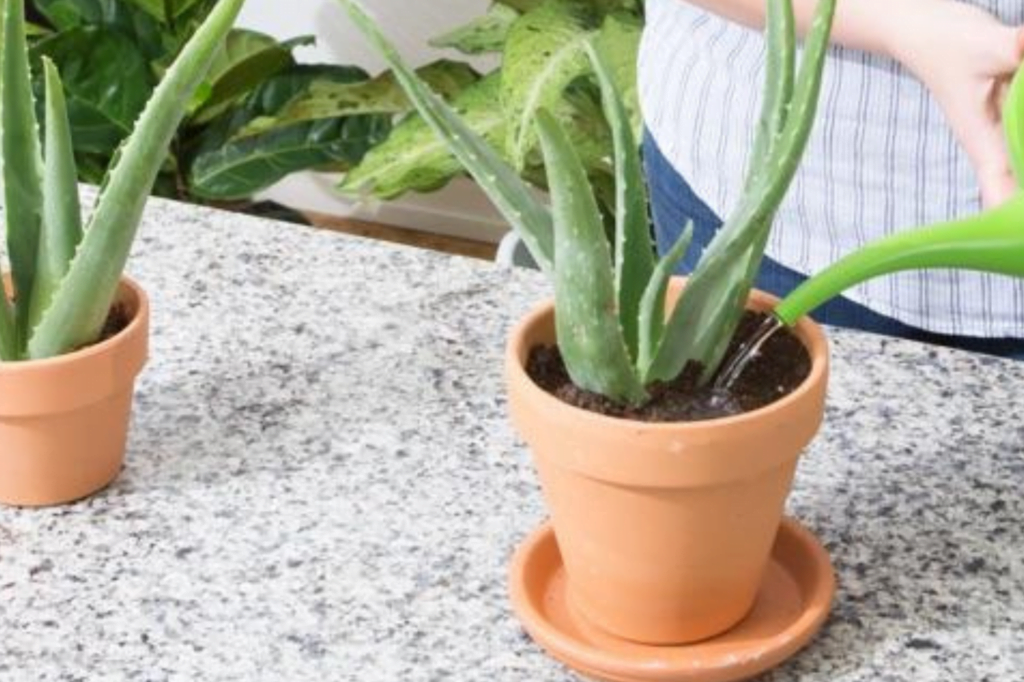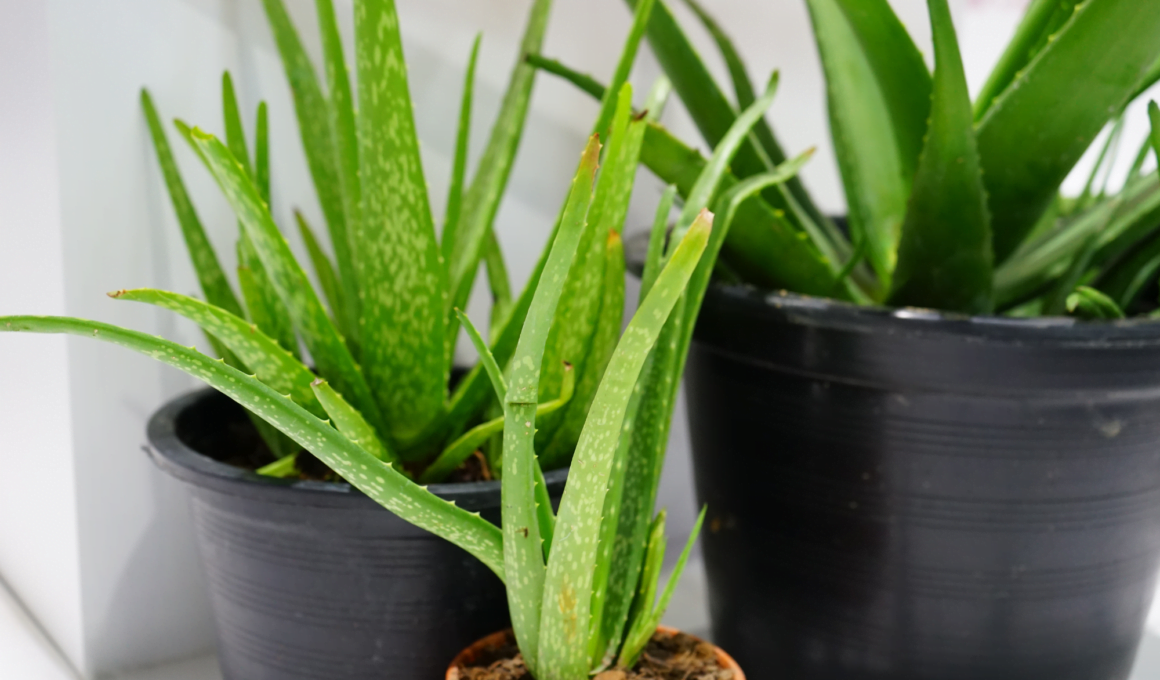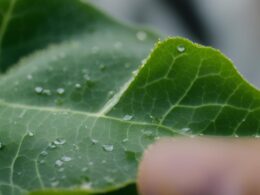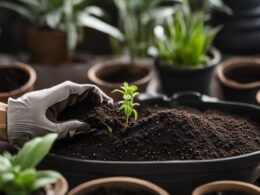Quick Summary
- Aloe vera plants should be watered when the top inch of soil feels dry
- Overwatering can lead to root rot and fungal diseases, so it’s important to avoid overwatering
- A consistent watering schedule should be established, adjusting the frequency based on seasonal changes
- Well-draining soil and pots with drainage holes should be used to prevent waterlogged roots and promote proper drainage
Understanding Aloe Vera’s Watering Needs
Don’t underestimate the importance of understanding how often you should water your aloe vera plant—it could make all the difference in keeping it thriving and happy! Aloe vera plants have specific watering needs that must be met to ensure their health. One of the key factors to consider is watering frequency. Aloe vera plants are succulents, which means they store water in their leaves. This allows them to survive in arid conditions, but it also means they are susceptible to overwatering. You want to avoid drowning your aloe vera by watering it too frequently. Instead, aim for a more moderate watering schedule.
As a general rule of thumb, water your aloe vera plant every two to three weeks. However, it’s essential to take into account the moisture levels in the soil. Before watering, check the moisture level by sticking your finger about an inch into the soil. If it feels dry, it’s time to water. If it still feels moist, wait a few more days before watering.
By understanding the watering frequency and monitoring the moisture levels, you can ensure your aloe vera plant receives the right amount of water to thrive and stay healthy.
One of the key factors to consider is watering frequency. Aloe vera plants are succulents, which means they store water in their leaves. This allows them to survive in arid conditions, but it also means they are susceptible to overwatering. You want to avoid drowning your aloe vera by watering it too frequently. Instead, aim for a more moderate watering schedule.
As a general rule of thumb, water your aloe vera plant every two to three weeks. However, it’s essential to take into account the moisture levels in the soil. Before watering, check the moisture level by sticking your finger about an inch into the soil. If it feels dry, it’s time to water. If it still feels moist, wait a few more days before watering.
By understanding the watering frequency and monitoring the moisture levels, you can ensure your aloe vera plant receives the right amount of water to thrive and stay healthy.
Factors to Consider when Watering Aloe Vera
Make sure you take into account various factors, such as the plant’s environment and soil moisture, when giving your aloe vera the right amount of hydration. Here are four key factors to consider when watering your aloe vera:- Watering frequency: Aloe vera is a succulent plant that stores water in its leaves, so it doesn’t require frequent watering. Overwatering can lead to root rot, which can be harmful to your plant. It’s best to water your aloe vera only when the top inch of soil feels dry to the touch.
- Watering methods: When watering your aloe vera, it’s important to use the right watering method. Instead of pouring water directly onto the leaves, which can cause them to rot, water the soil around the plant. Allow the water to soak in and then drain out completely.
- Environmental factors: Consider the temperature and humidity levels in your plant’s surroundings. Aloe vera prefers warm and dry conditions, so make sure to avoid overwatering in high humidity or during cooler months when the plant is dormant.
- Soil moisture: Check the moisture level of the soil before watering. Aloe vera prefers well-draining soil, so make sure the soil isn’t overly wet or soggy. It’s important to maintain proper soil moisture to prevent root rot and ensure the overall health of your aloe vera plant.
Establishing a Watering Schedule
To ensure the optimal health of your aloe plant, it’s important to establish a consistent watering schedule that takes into account its unique needs. Establishing a watering routine is crucial in maintaining the overall well-being of your aloe vera. But how often should you water it? Well, the frequency of watering depends on several factors, such as the climate, humidity levels, pot size, and soil type. A good rule of thumb is to let the soil dry out completely between waterings. Overwatering can lead to root rot and other issues, so it’s better to underwater than to overwater your aloe vera. Determining the optimal water amount is another key aspect of establishing a watering schedule. Too little water can cause the leaves to become dry and shriveled, while too much water can lead to root rot. It’s important to find the right balance. To help you visualize the watering needs of your aloe vera, here’s a table that outlines the general guidelines:| Climate | Humidity Level | Watering Frequency |
|---|---|---|
| Hot | Low | Once every 2 weeks |
| Cold | High | Once every 3 weeks |
| Moderate | Moderate | Once every 3-4 weeks |
Proper Watering Techniques for Aloe Vera
When it comes to properly watering your aloe vera plant, there are a few key techniques to keep in mind. First, consider watering from the bottom rather than pouring water directly onto the leaves. This helps prevent overwatering and allows the roots to absorb water at their own pace. Remember to avoid overwatering, as this can lead to root rot and other issues. By following these techniques, you’ll help keep your aloe vera plant healthy and thriving.
Remember to avoid overwatering, as this can lead to root rot and other issues. By following these techniques, you’ll help keep your aloe vera plant healthy and thriving.
Watering from the Bottom
Watering aloe vera from the bottom is a great way to keep your plant hydrated without the hassle of constantly checking the soil moisture. It’s a simple and effective technique that ensures your plant gets the right amount of water without the risk of overwatering. Here are four reasons why watering from the bottom is a safe and reliable method:- Prevents root rot: By watering from the bottom, you avoid moisture sitting on top of the soil, which can lead to root rot.
- Promotes healthy roots: This technique encourages the roots to grow deeper and stronger, resulting in a healthier and more resilient plant.
- Reduces the risk of fungal diseases: Watering from the bottom helps prevent the growth of fungi that thrive in moist conditions.
- Prevents leaf damage: By avoiding direct contact with the leaves, you minimize the risk of water spots or burns.
Avoiding Overwatering
Overwatering can be detrimental to the health of your aloe plant, so it’s crucial to find the right balance. To prevent root rot and ensure the well-being of your aloe vera, it’s important to avoid overwatering. One way to achieve this is by using the best watering containers for your plant. Opt for pots with drainage holes at the bottom to allow excess water to escape and prevent water from pooling around the roots. This will help to avoid waterlogged soil, which can lead to root rot. Additionally, consider using a well-draining soil mix specifically designed for succulents. This will further assist in preventing overwatering and maintaining the health of your aloe vera plant. Remember, finding the right balance is essential for the longevity and vitality of your aloe vera.Signs of Underwatering and Overwatering
Underwatering or overwatering can result in aloe vera leaves becoming shriveled and discolored. To ensure the health of your aloe vera plant, it’s important to be able to recognize the warning signs of both underwatering and overwatering. Here are four important signs to look out for:- Leaf Shrinking: Underwatered aloe vera leaves will start to shrink and become thin. They may also feel dry and brittle to the touch.
- Leaf Discoloration: Overwatered aloe vera leaves may turn yellow or brown, indicating root rot. Underwatered leaves may develop brown spots or become pale in color.
- Soft Leaves: Overwatered aloe vera leaves will feel soft and mushy. This is a clear sign of too much water, leading to root rot.
- Root Rot: If you notice a foul smell coming from the soil or see black, slimy roots when you remove the plant from its pot, it’s a sign of severe overwatering and root rot.
Is the Watering Schedule for Citronella Similar to Aloe Vera?
The watering citronella plant frequency differs from that of Aloe Vera. While Aloe Vera requires infrequent watering, usually once every two weeks, citronella plants prefer consistently moist soil and need to be watered at least once or twice a week. Hence, their watering schedules are not similar.
Adjusting Watering Frequency Based on Seasonal Changes
As the seasons change, it’s essential for you to adjust the frequency of how often you provide moisture to your aloe plant. Adjusting watering techniques based on seasonal changes is crucial to ensure the health and safety of your aloe vera. During the summer months, when the temperature rises and the air becomes drier, you may need to water your aloe vera more frequently. This is because the plant will lose moisture at a faster rate due to evaporation. On the other hand, in the winter months, when the air is colder and humidity levels are higher, you should reduce the frequency of watering. Overwatering during this time can lead to root rot and other problems. It is important to monitor the moisture levels of the soil and adjust your watering schedule accordingly. Remember to always check the soil before watering and only provide moisture when the top inch of soil feels dry. By making these seasonal watering adjustments, you can ensure that your aloe vera thrives all year round.Additional Tips for Maintaining Aloe Vera’s Health
One helpful tip for keeping your aloe plant healthy is to regularly check the moisture levels in the soil and adjust your watering schedule accordingly. Maintaining aloe vera’s appearance and preventing root rot are important aspects of caring for this plant. To ensure your aloe stays healthy and vibrant, here are some additional tips to follow:- Use well-draining soil: Aloe vera prefers soil that allows water to flow through easily. Choose a sandy or cactus mix soil to prevent water from sitting around the roots, which can lead to root rot.
- Avoid overwatering: Aloe plants are succulents and store water in their leaves. They are adapted to survive in arid conditions, so they don’t require frequent watering. Allow the soil to dry out completely between waterings to prevent overwatering and root rot.
| Season | Watering Frequency |
|---|---|
| Spring | Once every 2-3 weeks |
| Summer | Once every 1-2 weeks |
| Fall | Once every 2-4 weeks |
| Winter | Once every 4-6 weeks |
Troubleshooting Common Watering Issues
To troubleshoot common watering issues, it’s important to assess the moisture levels in the soil and adjust accordingly. Here are some tips to help you prevent common watering mistakes and avoid root rot:- Overwatering: Check if the soil feels damp to the touch. If it does, hold off on watering until the top inch of the soil is dry. Overwatering can lead to root rot and other fungal diseases, so it’s important to let the soil dry out between waterings.
- Underwatering: If the soil feels dry and the leaves of your aloe vera plant start to shrivel or turn brown, it’s a sign that it needs water. Water the plant thoroughly until water seeps out of the drainage holes at the bottom of the pot. Make sure to allow excess water to drain away to prevent waterlogging.
- Proper drainage: Ensure that your aloe vera plant is in a pot with good drainage. Poorly draining soil can lead to waterlogged roots, which can cause root rot. You can add perlite or sand to the potting mix to improve drainage.









